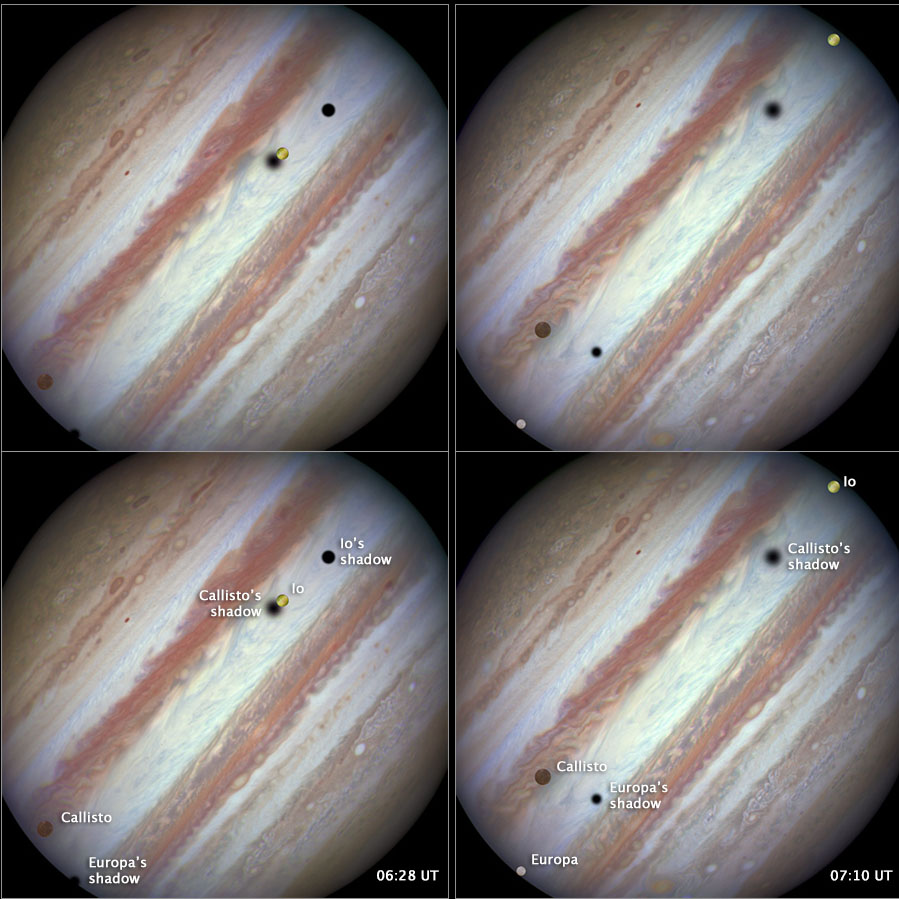3 min read

Firing off a string of action snapshots like a sports photographer at a NASCAR race, NASA's Hubble Space Telescope captured the rare occurrence of three of Jupiter's largest moons racing across the banded face of the gas-giant planet: Europa, Callisto, and Io.
These so-called Galilean moons, named after the 17th century scientist Galileo Galilei, who discovered them with a telescope, complete orbits around Jupiter with durations ranging from 2 days to 17 days. They can commonly be seen transiting the face of Jupiter and casting shadows onto its cloud tops. However, seeing three moons transiting the face of Jupiter at the same time is rare, occurring only once or twice a decade.
The Hubble image on the left shows the beginning of the event, which took place on January 24, 2015. From left to right, the moons Callisto and Io are above Jupiter's cloud tops. The shadows from Europa, Callisto, and Io are strung out from left to right. Europa is not visible in this image.
Near the end of the event, approximately 42 minutes later (right-side image) Europa has entered the frame at lower left. Slower-moving Callisto is above and to the right of Europa. Fastest-moving Io is approaching the eastern limb of the planet; its shadow is no longer visible on Jupiter. Europa's shadow is toward the left side of the image, and Callisto's shadow to the right. The moons' orbital velocities are proportionally slower with increasing distance from the planet.
Missing from the sequence is Ganymede, one of the four Galilean moons that was outside Hubble's field of view and too far from Jupiter to be part of this conjunction.
The moons in these photos have distinctive colors. The ancient cratered surface of Callisto is brownish; the smooth icy surface of Europa is yellow-white; and the volcanic, sulfur-dioxide surface of Io is orange. The apparent “fuzziness” of some of the shadows depends on the moons’ distances from Jupiter. The farther away a moon is from the planet, the softer the shadow, because the shadow is more spread out across the disk.
The images were taken with Hubble's Wide Field Camera 3 in visible light.
The Hubble Space Telescope is a project of international cooperation between NASA and the European Space Agency. NASA's Goddard Space Flight Center in Greenbelt, Maryland, manages the telescope. The Space Telescope Science Institute (STScI) in Baltimore conducts Hubble science operations. STScI is operated for NASA by the Association of Universities for Research in Astronomy, Inc., in Washington, D.C.
For images and more information about the Hubble Space Telescope, visit: http://hubblesite.org/news/2015/05 or http://www.nasa.gov/hubble
Contacts:
Ray Villard
Space Telescope Science Institute, Baltimore, Md.







